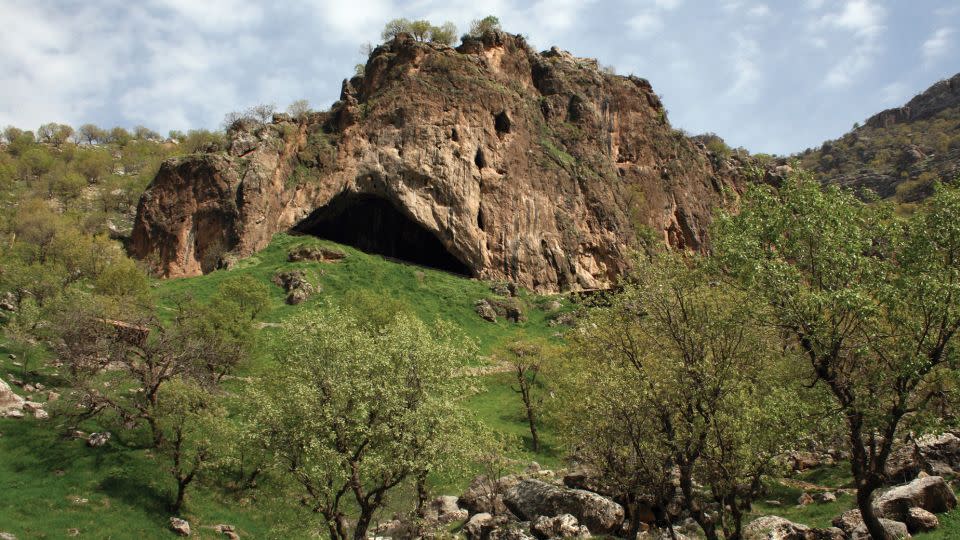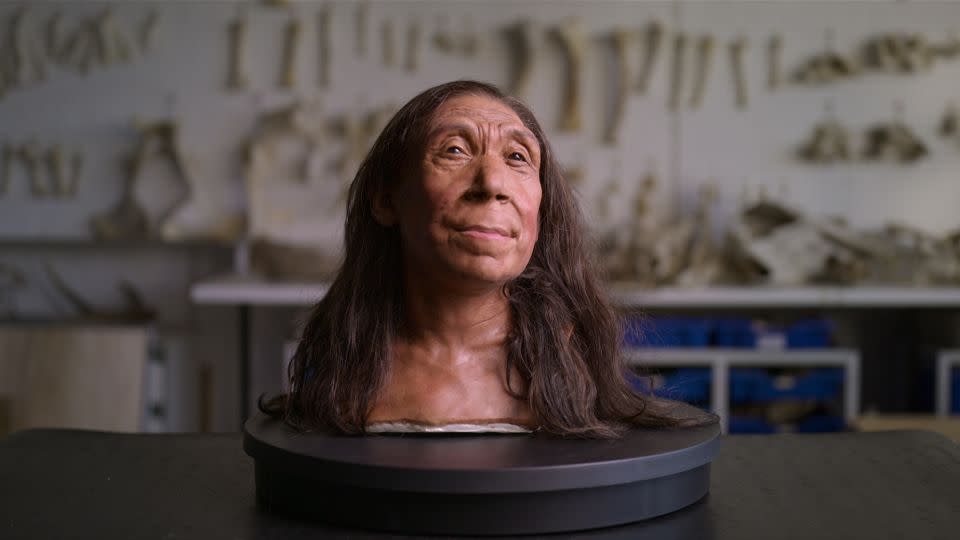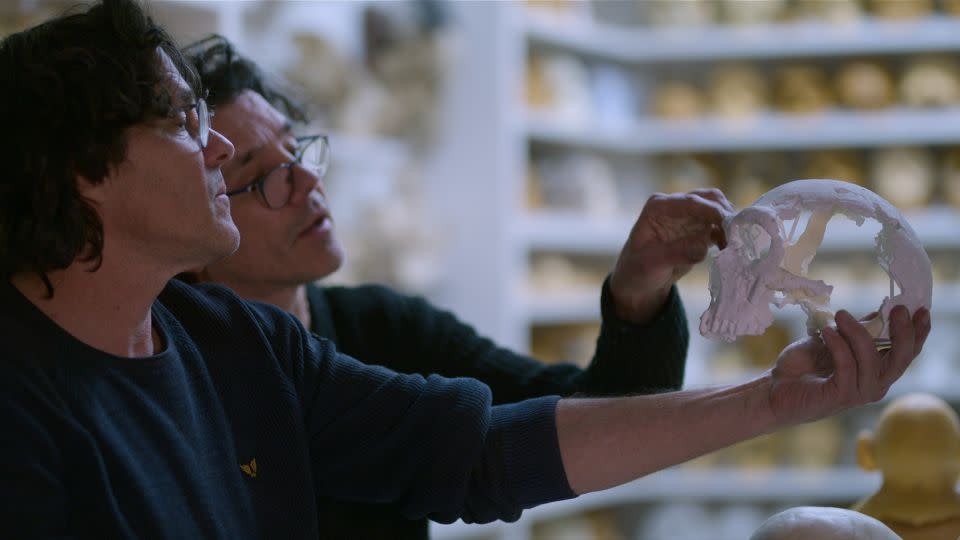Scientists reveal the face of a Neanderthal who lived 75,000 years ago
Sign up for CNN’s Wonder Theory science newsletter. Explore the universe with information on fascinating discoveries, scientific advances and much more..
A woman in her forties was buried in a cave 75,000 years ago, in a ravine dug to accommodate her body. His left hand was curled under his head and a stone behind his head may have been placed as a cushion.
Known as Shanidar Z, named after the cave in Iraqi Kurdistan where she was found in 2018, the woman was a Neanderthal, a type of ancient human that went extinct around 40,000 years ago.
Scientists who studied his remains painstakingly reconstructed his skull from 200 bone fragments, a process that took nine months. They used the contours of the face and skull to guide a reconstruction to understand what she might have looked like.
This striking recreation is featured in a new documentary “Secrets of the Neanderthals” produced by the BBC for Netflix, available to stream on Thursday.
With pronounced brow ridges and no chins, the skulls of Neanderthals are different from those of our own species, Homo sapiens, said Dr Emma Pomeroy, a paleoanthropologist and associate professor in the Department of Archeology at the University of Cambridge who unearthed the skeleton and appears in the new film. Shanidar Z’s facial reconstruction suggests that these differences might not have been as marked in life, Pomeroy said.
“There is some artistic license there, but at the heart of it is the real skull and the real data about what we know about (these) people,” she said.
“She actually has a pretty wide face for her height,” Pomeroy added. “She has quite large brow bones, which we wouldn’t usually see, but I think dressed in modern clothes you probably wouldn’t look twice.”
Neanderthals lived in the mountains of Europe, the Middle East, and Central Asia for about 300,000 years, overlapping with modern humans for about 30,000 years. Analysis of the DNA of modern-day humans has revealed that during this era, Neanderthals and Homo sapiens occasionally met and interbred.


New analysis
When Pomeroy first excavated the skeleton, its sex was not immediately obvious because only the upper half of the body was preserved. She was missing telltale pelvic bones. The team that initially studied the remains relied on a relatively new technique involving sequencing proteins inside tooth enamel to determine the sex of Shanidar Z, which is first revealed in the documentary .
These researchers from the Universities of Cambridge and Liverpool estimated the height of the specimen at around 1.5 meters by comparing the length and diameter of its arm bones with data on modern humans. An analysis of tooth and bone wear suggested she was in her 40s at the time of her death.
“It’s a reasonable estimate, but we can’t be 100 percent sure they weren’t older,” Pomeroy said. “What we can say is that he is someone who lived a relatively long life. For this society, they would probably have been very important in terms of knowledge, life experience.


The cave where Shanidar Z was buried is well known to archaeologists because a Neanderthal grave discovered there in 1960 led researchers to believe that Neanderthals might have buried their dead with flowers – the first challenge to the prevailing idea according to that ancient humans were stupid and brutal. . Subsequent research by Pomeroy’s team, however, cast doubt on this theory of flower burial.
Instead, they suspect that the pollen discovered among the graves may have arrived via pollinating bees.
Yet over the years, scientists have discovered more and more evidence of Neanderthal intelligence, sophistication, and complexity, including art, ropes, and tools.
Neanderthals returned to Shanidar Cave several times to rest their dead. The remains of 10 Neanderthals were discovered at the site, half of which appear to have been deliberately buried in succession, research shows.
Neanderthals may not have honored their dead with bouquets of flowers, but the inhabitants of Shanidar Cave were likely an empathetic species, research suggests. For example, a Neanderthal buried there was deaf and suffered from a paralyzed arm and head trauma that likely left him partially blind. However, he lived a long time and therefore had to be treated, according to research.
Shanidar Z is the first Neanderthal discovered in the cave in more than 50 years, Pomeroy said, but the site could still yield more discoveries. While filming the documentary in 2022, Pomeroy discovered a left shoulder blade, ribs and a right hand belonging to another Neanderthal.
“I think our interpretation at the moment,” she said, “is that in reality these are probably the remains of a single individual, which was then disturbed.”


Reconstruct the skull
Pomeroy described reconstructing Shanidar Z’s skull, which was crushed relatively soon after his death, as a “high-stakes 3D puzzle.” The fossilized bones were hardened with a glue-like substance, removed into small blocks of cave sediment and wrapped in aluminum foil before researchers sent them to the University of Cambridge for analysis.
In the Cambridge laboratory, researchers took micro-CT scans of each block and used these scans to guide the extraction of bone fragments. Pomeroy’s colleague, Dr. Lucía López-Polín, archaeological curator at the Catalan Institute of Human Paleoecology and Social Evolution in Spain, reconstructed more than 200 pieces of skull with the naked eye to restore it to its original shape.
The team scanned and 3D printed the reconstructed skull, which formed the basis of a reconstructed head created by Danish paleoartists Adrie and Alfons Kennis, twin brothers who built layers of engineered muscle and skin to reveal the face by Shanidar Z.
Pomeroy said the reconstruction helped “bridge the gap between anatomy and 75,000 years.”
For more CNN news and newsletters, create an account at CNN.com
yahoo


